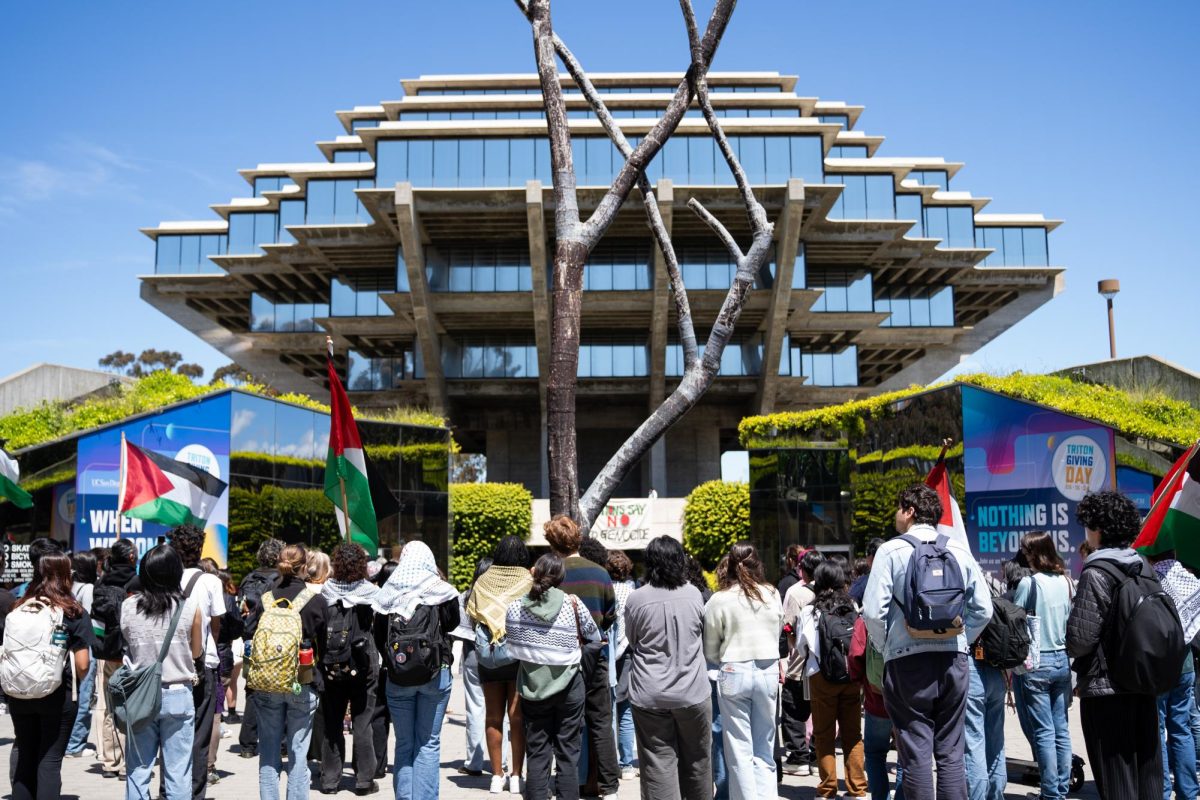Protesters against the UCSD School of Medicine’s use of dog labs gathered outside of the Basic Sciences Building on Feb. 19, while freshman students inside vivisected dogs in a half-day lab that ends in the euthanizing of the animals. A total of 24 dogs were ordered this year.
Speakers included Lawrence Hansen, a professor of pathology and neurosciences at the School of Medicine, and Nancy Harrison, a pathologist at the Scripps Memorial Hospital in Chula Vista. Both doctors have been active in the effort to end the use of UCSD’s dog labs for over five years, conducting surveys of medicine schools nationwide.
“”We tried for five years to go through the appropriate committees,”” Hansen said. “”We didn’t want to resort to public pressure until we had exhausted other options, but we hope that this publicity will cause the school to think this over again.””
According to Hansen’s survey of all 125 medical schools in the United States, which was published in the November 2002 issue of American Medicine, 95 percent of schools don’t kill animals in their pharmacology courses, and 82 percent don’t kill animals in physiology. At most institutions, according to Hansen, the labs have been replaced with computer simulations.
“”The best medical schools in the country — Harvard, Stanford, Yale, Columbia — don’t kill dogs,”” Harrison said. “”Why should we?””
Hansen and Harrison formed Doctors against Dog Labs and started a petition that has over 150 signatures. According to their Web site, the petition includes 34 members of the UCSD faculty, 13 School of Medicine graduates, 20 UCSD resident fellows and representatives of 12 hospitals in San Diego county.
“”Killing dogs is outside the mainstream by now,”” Hansen said. “”I think that MDs know that it’s unnecessary, but Ph.D.s tend to be obsessive about their research — but we physicians practice and see that it’s not useful.””
Dog labs, according to Hansen and other speakers, are not used for research, and are repeated each year in the same manner.
The dogs, which are purpose-bred for experimentation, are anesthetized and injected with various drugs that raise and lower their heart and breathing rates. Five students and dog observe the processes, all the while monitoring the data input.
“”This gives students an experience which really cements knowledge into place,”” said professor of pharmacology and medicine Lawrence Brunton, who runs the labs. “”The information that is extracted from the labs is in the course textbook, but what you can’t get from a textbook or a computer simulation is the physical experience of doing this.””
According to Brunton, it is most students’ first time having to respond to the data of a living subject.
“”In the textbook, students will learn one response to a drug,”” Brunton said. “”But in real life, there is biological variability, and students in the labs see that responses don’t always look like textbook responses.””
For this quarter’s first lab, 50 students out of 120 opted to skip the labs.
“”Test scores don’t show any difference at all between the people who have opted out and stayed in,”” said Anthony Adame, a sophomore who opted out. “”And that’s what you’re most worried about as a student.””
Freshmen are presented with information about the labs during orientation. According to Hansen, opponents of the labs were denied their request to be provided with an equal amount of time to present their views during orientation week.
“”I think there is some pressure to do the labs, especially UCSD being such a prestigious school,”” said Solomon Maya, a junior who opted out of the labs. “”But the most pressure is from other students, not really the university. It’s their own choice.””
Brunton, who said that the lab was started an hour early so that students participating would not feel pressure from the protesters, felt that there was pressure on students from both sides.
“”This year, the peer pressure seems to run to the side of opting out,”” Brunton said. “”Some students also got anti-vivisection literature in their mailboxes, and that disturbed them.””
According to Hansen, freshmen do not yet have the perspective necessary to decide whether or not to attend the labs.
“”I killed two dogs in medical school, and I practice medicine, but never once have I had to make a tough diagnosis and looked back and said, ‘If only I killed more dogs,'”” Hansen said.
UCSD pathologist Carla Stayboldt recalled her experience with dog labs 20 years ago.
“”That experience was very different from my surgical experience, where we used dogs to learn surgery under sterile technique, and the dogs lived,”” Stayboldt said. “”I didn’t realize what we were doing was wrong 20 years ago, but I know it’s wrong now.””
The dogs cost $576 each. UCSD started using dogs in 1968, but used pound dogs slated for killing until, according to Brunton, pressure from protesters made the school turn to buying dogs from private breeders.
“”The school says it’s humane because the dogs are anesthetized,”” Hansen said. “”But that discounts all the years they’ve spent in a cage.””
Brunton has worked with the labs for 20 years and has seen the number of dogs used diminish to about one-third of the original number. He called the labs “”modern.””
“”It’s not the lab that other schools have given up,”” Brunton said. “”The reason that other schools don’t do this lab is that, to some extent, they’ve been intimidated by animal rights movements, lack resources and also, to some extent, have already lost this knowledge.””
Protesters of the San Diego community were also present at the protest, including several animal rights activists who started chanting, and were asked to be quiet.
“”This is a calm, mainstream, respectable effort,”” Harrison said. “”It’s a very simple issue that every San Diego citizen has the ability to understand. You don’t need to be an MD to figure this out.””
The next lab is scheduled for Feb. 26.







